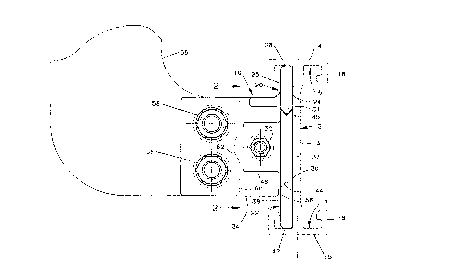Une partie des informations de ce site Web a été fournie par des sources externes. Le gouvernement du Canada n'assume aucune responsabilité concernant la précision, l'actualité ou la fiabilité des informations fournies par les sources externes. Les utilisateurs qui désirent employer cette information devraient consulter directement la source des informations. Le contenu fourni par les sources externes n'est pas assujetti aux exigences sur les langues officielles, la protection des renseignements personnels et l'accessibilité.
L'apparition de différences dans le texte et l'image des Revendications et de l'Abrégé dépend du moment auquel le document est publié. Les textes des Revendications et de l'Abrégé sont affichés :
| (12) Brevet: | (11) CA 2011158 |
|---|---|
| (54) Titre français: | PINCES POUR RAIL |
| (54) Titre anglais: | TRACK CLAMP ASSEMBLY |
| Statut: | Périmé et au-delà du délai pour l’annulation |
| (51) Classification internationale des brevets (CIB): |
|
|---|---|
| (72) Inventeurs : |
|
| (73) Titulaires : |
|
| (71) Demandeurs : |
|
| (74) Agent: | SMART & BIGGAR LP |
| (74) Co-agent: | |
| (45) Délivré: | 1999-03-30 |
| (22) Date de dépôt: | 1990-02-28 |
| (41) Mise à la disponibilité du public: | 1990-09-06 |
| Requête d'examen: | 1993-11-24 |
| Licence disponible: | S.O. |
| Cédé au domaine public: | S.O. |
| (25) Langue des documents déposés: | Anglais |
| Traité de coopération en matière de brevets (PCT): | Non |
|---|
| (30) Données de priorité de la demande: | ||||||
|---|---|---|---|---|---|---|
|
Cette invention concerne une pince destinée au supportage ou à l'éclissage de rails de section en I formés d'une âme verticale et de semelles horizontales parallèles aux extrémités opposées de l'âme, des gorges opposées étant définies dans les semelles du rail, de part et d'autre de l'âme de celui-ci. L'objet de l'invention comprend des éléments de serrage supérieur et inférieur ayant respectivement une rive supérieure et une rive inférieure adaptables dans les gorges opposées du rail et des rampes interchangeables entre les deux dites rives supérieure et inférieure et obliques par rapport auxdites rives. Des pattes faisant saillie vers l'extérieur sur les éléments de serrage sont adaptées pour recevoir un boulon dont le serrage a pour effet de rapprocher lesdites rampes l'une contre l'autre, ce qui a pour effet d'écarter les rives supérieure et inférieure des éléments de serrage pour les appuyer fermement en fonds de gorge du rail.
A track clamp assembly for supporting or splicing
tracks of I-shaped cross-section formed by a vertical
web with horizontal parallel flanges at the opposite ends
of the web and having a pair of oppositely facing grooves
formed in the flanges on each side of the web. The track
clamp assembly comprises upper and lower clamp members
respectively having upper and lower edges insertable in a
pair of track grooves, and having interengageable ramp
surfaces disposed between the upper and lower edges and
extending obliquely thereto. Outwardly projecting tabs on
the clamp members are engageable by a connecting bolt which
when tightened moves the ramp surfaces into interengagement,
increasing the dimension between the upper and lower edges
and forcing the clamp members into locking engagement with
the track.
Note : Les revendications sont présentées dans la langue officielle dans laquelle elles ont été soumises.
Note : Les descriptions sont présentées dans la langue officielle dans laquelle elles ont été soumises.

2024-08-01 : Dans le cadre de la transition vers les Brevets de nouvelle génération (BNG), la base de données sur les brevets canadiens (BDBC) contient désormais un Historique d'événement plus détaillé, qui reproduit le Journal des événements de notre nouvelle solution interne.
Veuillez noter que les événements débutant par « Inactive : » se réfèrent à des événements qui ne sont plus utilisés dans notre nouvelle solution interne.
Pour une meilleure compréhension de l'état de la demande ou brevet qui figure sur cette page, la rubrique Mise en garde , et les descriptions de Brevet , Historique d'événement , Taxes périodiques et Historique des paiements devraient être consultées.
| Description | Date |
|---|---|
| Inactive : CIB de MCD | 2006-03-11 |
| Le délai pour l'annulation est expiré | 2002-02-28 |
| Lettre envoyée | 2001-02-28 |
| Accordé par délivrance | 1999-03-30 |
| Inactive : Taxe finale reçue | 1998-12-15 |
| Préoctroi | 1998-12-15 |
| Un avis d'acceptation est envoyé | 1998-09-29 |
| Un avis d'acceptation est envoyé | 1998-09-29 |
| Lettre envoyée | 1998-09-29 |
| Inactive : Renseign. sur l'état - Complets dès date d'ent. journ. | 1998-09-22 |
| Inactive : Dem. traitée sur TS dès date d'ent. journal | 1998-09-22 |
| Inactive : Approuvée aux fins d'acceptation (AFA) | 1998-08-10 |
| Exigences pour une requête d'examen - jugée conforme | 1993-11-24 |
| Toutes les exigences pour l'examen - jugée conforme | 1993-11-24 |
| Demande publiée (accessible au public) | 1990-09-06 |
Il n'y a pas d'historique d'abandonnement
Le dernier paiement a été reçu le 1999-01-04
Avis : Si le paiement en totalité n'a pas été reçu au plus tard à la date indiquée, une taxe supplémentaire peut être imposée, soit une des taxes suivantes :
Veuillez vous référer à la page web des taxes sur les brevets de l'OPIC pour voir tous les montants actuels des taxes.
| Type de taxes | Anniversaire | Échéance | Date payée |
|---|---|---|---|
| TM (demande, 8e anniv.) - générale | 08 | 1998-03-02 | 1997-12-23 |
| Taxe finale - générale | 1998-12-15 | ||
| TM (demande, 9e anniv.) - générale | 09 | 1999-03-01 | 1999-01-04 |
| TM (brevet, 10e anniv.) - générale | 2000-02-28 | 2000-01-11 |
Les titulaires actuels et antérieures au dossier sont affichés en ordre alphabétique.
| Titulaires actuels au dossier |
|---|
| JERVIS B. WEBB COMPANY |
| Titulaires antérieures au dossier |
|---|
| CLAYTON C. MCDONALD |
| EDWARD M. JR. DUCZKOWSKI |